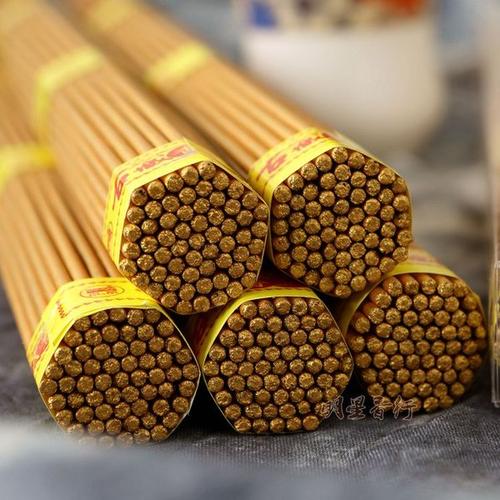What is the origin of Jiangmen bamboo stick incense and Buddhism
Before the introduction of Buddhism into China, incense had a close relationship with people's lives. In addition to following the introduction of Buddhism through burning, various important spices such as dragon brain and agarwood were continuously introduced, giving a new look to the use of incense.
The concept of harmonious fragrance introduced by Buddhism quickly combined with the concept of medicinal use in China, resulting in a versatile and knowledgeable formula for harmonious fragrance. Even ideal fragrances were formulated according to seasons, occasions, and purposes. In terms of fragrance, there are various shapes such as pill, powder, cake, thread, and circle. Starting from the Ming and Qing dynasties, there was also the presentation of pillar incense, which used bamboo or wooden sticks as the central pillar and wrapped in fragrant powder, becoming one of the commonly used incense products at present.
Buddhism believes that there is a great connection between incense and human intelligence and virtue. The wonderful incense is closely related to the perfect intelligence and heart. Through communication between incense lovers and Buddhas and Bodhisattvas, incense is the thread. Buddha relies on a stick of incense, and all sages have wonderful incense in their bodies. People use incense to tighten their bodies.
In the Sutra of Suxi, incense is listed as one of the five offerings, and in the "Great Classic", it is listed as one of the six important offerings. In various practices of tantric Buddhism, there are often records of offering incense, and according to the offerings of the Buddha, Lotus, Vajrayana, and Heavenly Dragon Eight, all the protectors of the world are offered with different incense according to their respective needs. Agarwood is used to offer sacrifices to the Buddhist sect.
In the solemn Buddhist scripture of Da Tong Fang Guang's repentance and eradication of sins, it is detailed that the offering of scriptures should also be accompanied by various wonderful fragrances and solemn sounds. In the Mahaprajnaparamita Sutra, there is a method of noisy repentance of the nasal roots; In the repentance ceremony of the charity dojo, there are detailed vows about the nasal roots and incense. In the practice of liver leaf copying, spreading incense represents abstaining from honey, and burning incense represents refining honey.

According to the recitation ritual of the Buddha's top revered Tripitaka, it is said that in the method of relieving disasters, incense should be burned in the form of submerged water. There are also similar sayings in the Diamond Head Yoga Thousand Hands Thousand Eyes Avalokitesvara Bodhisattva Practice Manual and the Diamond Longevity Dharani Sutra.
Buddhism talks about the fragrance of the heart, but when reflecting on one's own situation, the fragrance produced by one's state of mind and (voice) virtue is called the fragrance of the heart. In the sutra, it is said: "To cultivate virtue, one must keep the fragrance of the heart, never consume it, and never give up one's mind." Buddhism teaches about precepts, steadfastness, and wisdom. From precepts, one can develop steadfastness, and from steadfastness, one can develop wisdom. Buddhism teaches that Prajnaparamita is wisdom, and ignorance is afflictions. The two are relative. Buddha does not emphasize affirmation, but rather the middle way, the attachment to both ends, neither birth nor extinction, neither purification nor impurity, and the mind is not troubled or fearful. Offering incense with heart to all Buddhas and Bodhisattvas has greater merit. During Buddha's lifetime, his disciples provided clothing, food, and other offerings. After the death of Buddha, there will be strict forms and rituals of offering as in his lifetime.
Any religion must use incense to offer, and one must be a messenger of incense to offer to the Buddhas. Incense is also an important offering in Buddhism, and using agarwood oil to spread incense is an even more remarkable offering. There are auspicious rituals, methods, mantras, handprints, etc. for offering incense in both the Golden Core Realm Dharma and the Protectorate Dharma. Here are some methods of offerings by Emperor Xianzong:
The Ten Offerings of Emperor Xianzong: Incense, Flower, Lamp, Tu, Fruit, Tea, Food, Treasure, Pearl, Clothing. The first type of offering is fragrance, which demonstrates the effectiveness of fragrance in Buddhist teachings. On the eighth day of April every year, during the Bathing Buddha Festival, monks bathe in fragrant soup, including agarwood, sandalwood, and other fragrances.
Three in One: Incense, Flower, Lantern Vase, Candlestick, Incense Burner
Five offerings: one incense burner, one pair of vases, and one pair of candlesticks (standard offerings)
Ten offerings: incense, flowers, lamps, paints, fruits, tea, food, treasures, pearls, clothing
Fragrance: Chen, Tan, Long, Musk
Flower: represents' good appearance 'in the afterlife due to' cause '
Lamp: Oil lamp, butter lamp, indicating mood and brightness
Tu: Tu Xiang
Fruit: represents "fruit"
Treasure: All kinds of wonderful treasures in the world
Pearls: pearls, jewelry
Clothing: Robe, Yingluo
Article source: Jiangmen bamboo stick fragrance manufacturerhttp://www.dongfangxl.com/
-
09-30
What are the structures of bamboo stick incense?
Bamboo stick incense, also known as string incense, stick incense, or standing incense in Taiwan, and bamboo stick incense in mainland China, is named after its use of bamboo branches, cinnamon bamboo
-
09-30
Incense Manufacturer: Craftsmanship for Making Bamboo Stick Incense
The ancients discovered that any type of spice has the effects of refreshing and calming the mind, so the history of incense burning in China has been over 3000 years, and China can be considered one
-
09-08
Fragrant powder and spice factory: production techniques for bamboo stick fragrance
Nowadays, when making bamboo stick incense, the following methods should be used first:1. Traditional craftsmanship involves hand pouring fragrance.2. Handmade powder coating and mechanical bucket mak
-
08-26
Fragrant powder and spice factory: How to distinguish the quality of bamboo stick fragrance?
We call fragrances made from natural spices "natural fragrances", fragrances with artificially synthesized spices "chemical fragrances", or perhaps "fragrance crafts". Chemical fragrance only has the
